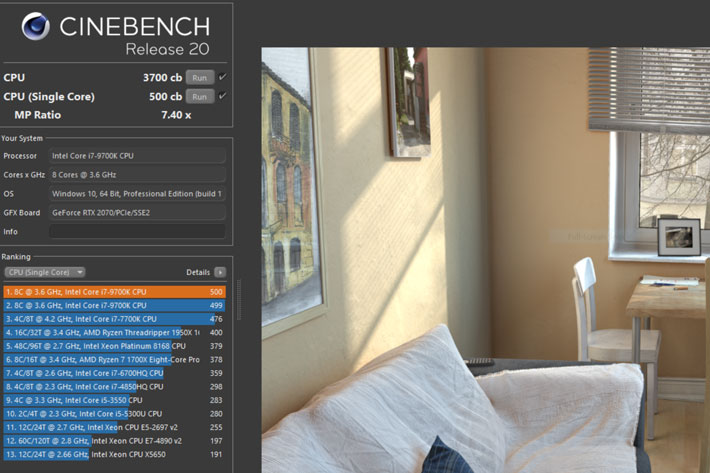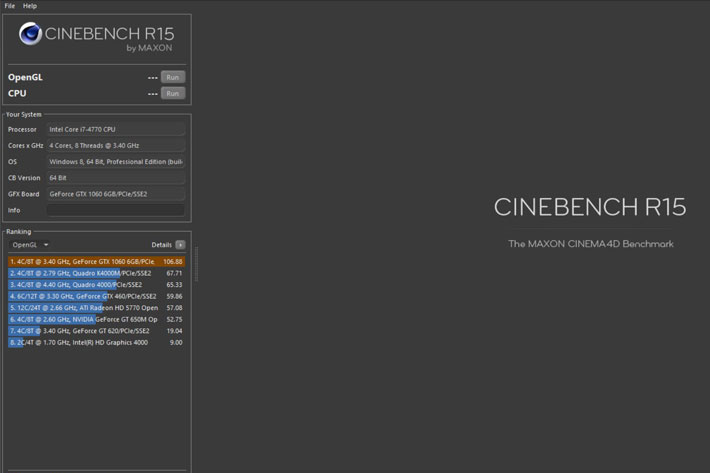
How powerful is your computer? Test it with the FREE Cinebench! The new Release 20 is available now and is much different from the R15 widely used to evaluate computer hardware capabilities.
When I recently wrote here at ProVideo Coalition one article entitled Building the ultimate PC for After Effects, I mentioned Cinebench, from Maxon, the cross-platform test suite used as a standard to many of the benchmarks published online, and added then that the company had released, recently, a new version, Cinebench Release 20, which reflects the overall advancements to CPU and rendering technology in recent years. I promised, then, that I would get back to the subject, and the time is now, because I had a chance to use the test suite on my brand new machine and, to some extent, compare results with those from my previous build.
Before I share my numbers with you, let me explain what Cinebench Release 20 or Cinebench R20, as is also called, represents. For over a decade, Cinebench has been a popular tool to evaluate hardware performance. Cinebench scores are used by system administrators to help make purchase decisions, journalists to review hardware, hardware manufacturers to optimize their latest products, as well as computer owners to evaluate their individual system. The test suite represents a real world scenario, as it uses the same same powerful 3D engine found in the animation software Cinema 4D.

Cinebench R20 and R15 can not be compared
This version, based on Release 20 is different from the previous, R15, as it reflects the overall advancements to CPU and rendering technology in recent years, providing a more accurate measurement of Cinema 4D’s ability to take advantage of multiple CPU cores and modern processor features available to the average user. Maxon says that because “Cinebench R20 uses a much larger and more complex test scene than R15, requiring about 8x the computational power needed to render it. The test also requires about 4x the memory. Therefore, R15 and R20 results cannot be compared.”
The test suite incorporates, as Cinema 4D R20 does, the latest rendering architectures, including integration of Intel’s Embree raytracing technology and advanced features on modern CPUs from AMD and Intel that allow users to render the same scene on the same hardware twice as fast as previously. In fact, according to Maxon, “Cinebench R20 provides improved benchmark accuracy for current and next-generation CPUs to test if a machine runs stable on a high-CPU load, if the cooling solution of a desktop or notebook is sufficient for longer-running tasks to deliver the full potential of the CPU, and if a machine is able to handle demanding real-life 3D tasks.”
Cinebench R20 does not test the GPU
In a world where so much is asked from the GPU, it is important to know that Cinebench R20 does not test GPU performance, so the key element being tested here is the CPU in your machine. Maxon also warns users of the software that “Cinebench R20 will not launch on unsupported processors. On systems lacking sufficient RAM to load the test scene, a warning will be displayed and the CPU benchmark will not be executed.”
So, you’ve two key elements to deal with: CPU and memory. It is also important to know that background tasks can significantly influence measurement and create diverse results. It’s always a good idea to shut down all running programs and disable any virus checking or disk indexing but it’s impossible to eliminate all background processes. Modern operating systems perform various background tasks that cannot or should not be disabled, even though they could have a minor influence on the results.
Cold weather and benchmarks
Because of this, test results can vary slightly because it’s impossible to disable every background task of the operating system. These tasks are one factor that may have a slight influence on measurements, says Maxon, to which I can add “but if you’re looking to get a real world benchmark, having those background systems running makes complete sense”. You’re not running a competition, but trying to understand how powerful your system is under NORMAL conditions. Right?
Maxon also points to the fact that “modern computers and graphics cards dynamically adjust clock speeds based on environmental conditions like power and temperature. For instance, processors will reduce clock speed when running too hot to allow for cooling and prevent damage. With many modern processors, the reverse is also true. They are able to overclock themselves when the temperature is low enough. Therefore, a system freshly started in a relatively cool environment will typically run faster than the same system that has been performing benchmarks for several hours in a heated office.” This will also mean that benchmarks coming from hot climates will be different from those in places closer to the poles, so you know!
8 cores against 60 cores/120 threads
Benchmarking my system with the new Cinebench R20 makes me believe I’ve made a good choice when I decided to buy an Intel i7 9700K to pair with the GeForce RTX 2070 and 32GB of 3200MHz RAM. Coming from a Haswell i7 4770 with a GeForce 1060 and 16GB of RAM, even if I can not compare the numbers given to me by Cinebench R15 and now the R20, in real world tasks I feel how much faster the new build is. We’re talking 4 cores and 8 threads in a 3.4GHz CPU against the 8 cores of the Intel i7 9700K at 3.6GHz, which runs at higher speeds when the system feels the right conditions are met.
While I can not compare numbers from the old and new machine, the ranking achieved by my humble new build in Cinebench R20’s multi-core tests shows that the “brute force” of Intel’s 8 cores places the i7 9700K in a very comfortable fourth position, only behind solutions as the 48 cores/98 threads 2.7GHz Intel Xeon Platinum 8161, the 60 cores/120 threads 2.8GHz Intel Xeon E7-4890 v2 and the 16 cores/32 threads 3.4GHz AMD Ryzen Threadripper 1950X.
Intel’s one core “brute-force”
Because many apps are still only using the power of one core, it is important to know how fast your machine can be when only a single core is used, even if you can boast your CPU has 60 cores and 120 threads. It is also important to understand if Intel made a mistake by not having cores and threads in some of the new CPUs. Well, Cinebench Release 20 has a test just to check how single core operations are handled. This test will run Maxon Cinebench as if there were only one CPU core available in your machine. This can be useful to have an indicator of how well the computer performs single-threaded tasks.
Running the test, I’ve a winner!” My build comes first, with a score of 500. And the second place – third in the graph because I ran the test twice – is the Intel i7 7700K, with a score of 476. The AMD Ryzen Threadripper 1950X comes in fourth place, with a score of 400, and a CPUs as the 60 cores/120 threads 2.8GHz Intel Xeon E7-4890 v2 comes in 12th place with a score of… 197. Again, it’s Intel’s one core “brute-force” at work …
Free, and available for PC and Mac
The numbers I got from benchmarking using Cinebench Release 20 and the general feeling I get from the new build I am using now point to a wise choice, which was helped by reading some of the info available from Puget Systems. I’ve built, I believe, a working computer that will last for some time, as my Haswell did. Or in fact does, as it is going to be reused to build a support machine, as the Cinebench R15 still gives it a good place in terms of benchmarking.
If you’ve built a new computer and want to know how it performs, Cinebench R20 may be a software to download and use. Any computer owner can evaluate their individual system. Unlike abstract benchmarks, which only test specific functions of CPUs, Cinebench offers a real-world benchmark that incorporates a user’s common tasks within Cinema 4D to measure a system’s performance.
Cinebench Release 20 is FREE, is compatible with both PC and MAC, and needs machines with the following specifications to run: for PC, Windows 7 SP1 64-bit or higher, Intel or AMD 64-bit CPUwith SSE3 & 4GB RAM; for Mac, MacOS 10.11.6 or higher, 64-bit CPU running on Intel-based Apple Macintosh & 4 GB RAM.

